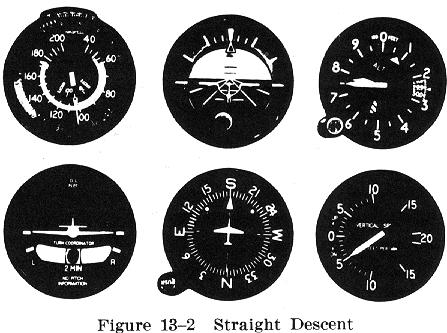Straight Descents
Straight Descents
When unexpected adverse weather is encountered by the VFR
pilot, the most likely situation is that of being trapped in or above a
broken or solid layer of clouds or haze, requiring that a descent be made
to an altitude where the pilot can reestablish visual reference to the
ground. Generally, the descent should be made in straight flight.
A descent can be made at a variety of airspeeds and vertical
speeds by reducing power, adding drag (gear and flaps), and lowering the
nose to a predetermined attitude. Before beginning the descent, it is recommended
that first the descent airspeed and the desired headings be established
while holding the wings level. In addition, the landing gear and flaps
should be positioned up or down, to help in maintaining either a slow rate
of descent, or a fast rate of descent, as desired. Establishing the desired
configuration before starting the descent will permit a more stabilized
descent and require less division of attention once the descent is started.
Rather than attempting to maintain a specific rate of descent, it is recommended
that only a constant airspeed be maintained.
| The following method for entering a descent is effective
either with or without an attitude indicator. First the airspeed is reduced
to the desired airspeed by reducing power while maintaining straight and
level flight. When the descent speed is established, a further reduction
in power is made, and simultaneously the nose is lowered to maintain a
constant airspeed (Fig. 13-2). The power should remain at a fixed (constant)
setting and deviations in airspeed corrected by making pitch changes. Jockeying
the throttle to control airspeed only adds to the pilot's workload.
If an attitude indicator is available, the pitch attitude can be adjusted
by reference to the representative airplane and the artificial horizon,
and then checking the airspeed indicator to determine if the attitude is
correct. Deviations from the desired airspeed are |
|
corrected by again adjusting the pitch attitude. If no attitude indicator
is available and the airspeed is too high or too low, the pilot should
apply only sufficient elevator pressure to start the airspeed pointer moving
toward the desired airspeed, since it takes a little time for the airspeed
to stabilize. Trying to "nail down" the airspeed immediately will only
result in overcontrolling. Additional pressure can then be added as necessary,
to attain the desired airspeed.
In any case, the pilot need not be concerned with slight
deviations in airspeed. The main objective is to descend at a safe airspeed
- well above the stall but not more than the airplane's design maneuvering
speed.
While descending, directional control should be maintained
by reference to the directional instruments just as described for straight
and level flight. Pilots are cautioned against "chasing" the instrument
pointers.
If any thought was given to the matter before starting
the flight, the pilot will have at least a rough idea of the height of
obstructions and terrain in the vicinity of the descent. Before starting
the descent, then, a decision must be made regarding the minimum altitude
to which the descent will be made.
